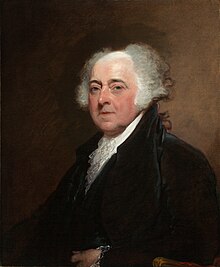
Back John Adams Afrikaans ጆን አዳምስ Amharic John Adams AN Iohannes Adams ANG جون آدامز Arabic دجون أدامز ARY جون ادامز ARZ জন আডামছ্ Assamese John Adams AST जॉन ऐडम्स AWA
John Adams | |
|---|---|
 Portrait c. 1800-1815 | |
| 2nd President of the United States | |
| In office March 4, 1797 – March 4, 1801 | |
| Vice President | Thomas Jefferson |
| Preceded by | George Washington |
| Succeeded by | Thomas Jefferson |
| 1st Vice President of the United States | |
| In office April 21, 1789 – March 4, 1797 | |
| President | George Washington |
| Preceded by | Office established |
| Succeeded by | Thomas Jefferson |
| 1st United States Minister to Great Britain | |
| In office April 1, 1785 – February 20, 1788[1] | |
| Appointed by | Congress of the Confederation |
| Succeeded by | Thomas Pinckney |
| 1st United States Minister to the Netherlands | |
| In office April 19, 1782 – March 30, 1788[1] | |
| Appointed by | Congress of the Confederation |
| Succeeded by | Charles W. F. Dumas (acting) |
| Chairman of the Marine Committee | |
| In office October 13, 1775 – October 28, 1779 | |
| Preceded by | Office established |
| Succeeded by | Francis Lewis (Continental Board of Admiralty) |
| 12th Chief Justice of the Massachusetts Superior Court of Judicature | |
| In office October 1775 – February 1777 | |
| Appointed by | Provincial Congress |
| Preceded by | Peter Oliver |
| Succeeded by | William Cushing |
| Delegate from Massachusetts to the Continental Congress | |
| In office September 5, 1774 – November 28, 1777 | |
| Preceded by | Office established |
| Succeeded by | Samuel Holten |
| Personal details | |
| Born | October 30, 1735 [O.S. October 19, 1735] Braintree, Massachusetts Bay, British America (now Quincy) |
| Died | July 4, 1826 (aged 90) Quincy, Massachusetts, U.S. |
| Resting place | United First Parish Church |
| Political party |
|
| Spouse | |
| Children | 6, including Abigail, John Quincy, Charles, and Thomas |
| Parents | |
| Education | Harvard College (AB, AM) |
| Occupation |
|
| Signature | |
John Adams (October 30, 1735 – July 4, 1826) was an American Founding Father who served as the second president of the United States from 1797 to 1801. Before his presidency, he was a leader of the American Revolution that achieved independence from Great Britain. During the latter part of the Revolutionary War and in the early years of the new nation, he served the U.S. government as a senior diplomat in Europe. Adams was the first person to hold the office of vice president of the United States, serving from 1789 to 1797. He was a dedicated diarist and regularly corresponded with important contemporaries, including his wife and adviser Abigail Adams and his friend and political rival Thomas Jefferson.
A lawyer and political activist prior to the Revolution, Adams was devoted to the right to counsel and presumption of innocence. He defied anti-British sentiment and successfully defended British soldiers against murder charges arising from the Boston Massacre. Adams was a Massachusetts delegate to the Continental Congress and became a leader of the revolution. He assisted Jefferson in drafting the Declaration of Independence in 1776 and was its primary advocate in Congress. As a diplomat, he helped negotiate a peace treaty with Great Britain and secured vital governmental loans. Adams was the primary author of the Massachusetts Constitution in 1780, which influenced the United States Constitution, as did his essay Thoughts on Government.
Adams was elected to two terms as vice president under President George Washington and was elected as the United States' second president in 1796. He was the only president elected under the banner of the Federalist Party. Adams's term was dominated by the issue of the French Revolutionary Wars, and his insistence on American neutrality led to fierce criticism from both the Jeffersonian Republicans and from some in his own party, led by his rival Alexander Hamilton. Adams signed the controversial Alien and Sedition Acts and built up the Army and Navy in an undeclared naval war with France. He was the first president to reside in the White House.
In his bid in 1800 for reelection to the presidency, opposition from Federalists and accusations of despotism from Jeffersonians led to Adams losing to his vice president and former friend Jefferson, and he retired to Massachusetts. He eventually resumed his friendship with Jefferson by initiating a continuing correspondence. He and Abigail started the Adams political family, which includes their son John Quincy Adams, the sixth president. John Adams died on July 4, 1826 – the fiftieth anniversary of the adoption of the Declaration of Independence. New Englanders Adams and his son are the only presidents of the first twelve who never owned slaves. Historians and scholars have favorably ranked his administration.
- ^ a b "John Adams (1735–1826)". United States Department of State: Office of the Historian. Retrieved September 30, 2018.
- ^ McCullough 2001, p. 599.